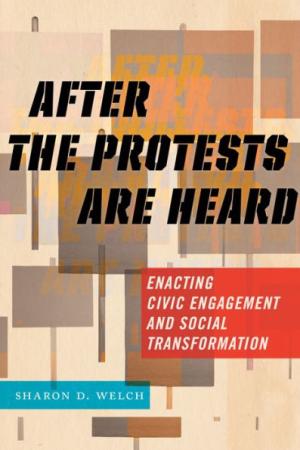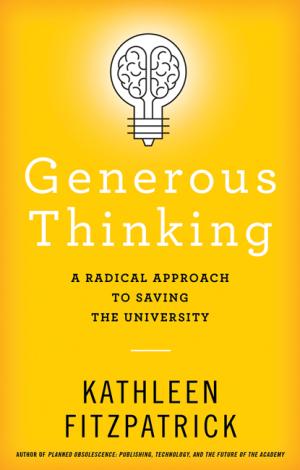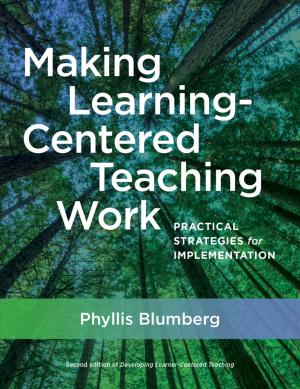Resources

From the Women’s March in D.C. to #BlackLivesMatter rallies across the country, there has been a rising wave of protests and social activism. These events have been an important part of the battle to combat racism, authoritarianism, and xenophobia in Trump’s America. However, the struggle for social justice continues long after the posters and megaphones have been packed away. After the protests are heard, how can we continue to work toward lasting change? This book is an invaluable resource for anyone invested in the fight for social justice. Welch highlights examples of social justice work accomplished at the institutional level. From the worlds of social enterprise, impact investing, and sustainable business, After the Protests Are Heard describes the work being done to promote responsible business practices and healthy, cooperative communities. The book also illuminates how colleges and universities educate students to strive toward social justice on campuses across the country, such as the Engaged Scholarship movement, which fosters interactions between faculty and students and local and global communities. In each of these instances, activists work from within institutions to transform practices and structures to foster justice and equality. After the Protests Are Heard confronts the difficult reality that social change is often followed by spikes in violence and authoritarianism. It offers important insights into how the nation might more fully acknowledge the brutal costs of racism and the historical drivers of racial injustice, and how people of all races can contain such violence in the present and prevent its resurgence in the future. For many members of the social justice community, the real work begins when the protests end. After the Protests Are Heard is a must-read for everyone interested in social justice and activism – from the barricades and campuses to the breakrooms and cubicles. (From the Publisher)

Higher education occupies a difficult place in twenty-first-century American culture. Universities—the institutions that bear so much responsibility for the future health of our nation—are at odds with the very publics they are intended to serve. As Kathleen Fitzpatrick asserts, it is imperative that we re-center the mission of the university to rebuild that lost trust. In Generous Thinking, Fitzpatrick roots this crisis in the work of scholars. Critical thinking—the heart of what academics do—can today often negate, refuse, and reject new ideas. In an age characterized by rampant anti-intellectualism, Fitzpatrick charges the academy with thinking constructively rather than competitively, building new ideas rather than tearing old ones down. She urges us to rethink how we teach the humanities and to refocus our attention on the very human ends—the desire for community and connection—that the humanities can best serve. One key aspect of that transformation involves fostering an atmosphere of what Fitzpatrick dubs "generous thinking," a mode of engagement that emphasizes listening over speaking, community over individualism, and collaboration over competition. Fitzpatrick proposes ways that anyone who cares about the future of higher education can work to build better relationships between our colleges and universities and the public, thereby transforming the way our society functions. She encourages interested stakeholders to listen to and engage openly with one another's concerns by reading and exploring ideas together; by creating collective projects focused around common interests; and by ensuring that our institutions of higher education are structured to support and promote work toward the public good. Meditating on how and why we teach the humanities, Generous Thinking is an audacious book that privileges the ability to empathize and build rather than simply tear apart. (From the Publisher)

This book analyses the structural and institutional transformations undergone by doctoral education, and the extent to which these transformations are in line with social, political and doctoral candidates' expectations. Higher education has gone through profound changes driven by the massification and diversification of the student body, the rise of neoliberal policies coupled with the reduction in public funding and the emergence of the knowledge society and economy. As a result, higher education has been assigned new and more outward-looking missions, which have subsequently affected doctoral education. The editors and contributors examine these transformations and changes at the macro, meso and micro levels: wider and more structural changes as well as doctoral candidates' experience of the degree itself. This book will be of interest and value to scholars of doctoral education and the transformation of the university more widely. (From the Publisher)

This book provides a practical philosophy for promoting students' sophisticated thinking from Early Childhood to PhD in ways that explicitly interconnect across the years of education. It will help teachers, academics and the broader learning and teaching community to understand and implement these connections by introducing a conceptual framework, the Models of Engaged Learning and Teaching (MELT). By covering the nature, philosophy, practice and implications of MELT for teachers and students alike, the book will help teachers to facilitate students’ awareness of, and increasing responsibility for, the thinking demanded by subject and discipline-specific learning as well as interdisciplinary learning, whether face to face, online or in blended modes. The book will also provide educators with ways to effectively engage with complex, and sometimes conflicting, contemporary educational concepts, and with a diverse variety of colleagues involved in the learning and teaching enterprise. The book provides guidance that allows curriculum improvement, teacher action research and larger-scale research to be reported on from a common perspective, bridging the gap between those readers focused on research and those focused on teaching. The book shares valuable insights and ways of addressing the contemporary issue of discipline-based learning versus transdisciplinary learning, reducing the dichotomy and enabling the two approaches to complement each other. (From the Publisher)

Theological education in the United States finds itself in untested circumstances today. Rapid social change is creating an increasing multicultural, multiracial, and multireligious context for leadership formation. At the same time, international enrollment, cross-border educational initiatives, student and faculty exchanges, and more are connecting US theological schools with a global community of Christian teaching and learning. How do US theological institutions “locate” themselves within this global ecology of theological formation so as to be both responsible participants and creative shapers within it? That is, how do they discern their proper place and role? It is questions like these that the contributors to this volume explore. Building on the decades-long discussion about the globalization of US theological education, this book argues that, in engaging such questions, US theological institutions have much to gain from a sustained conversation with the burgeoning literature on the internationalization of American higher education. This research offers theological institutions a trove of insights and cautionary tales as they seek to discern their rightful place and role in educating leaders in and for a global Christian church. (From the Publisher)

For a denomination like Roman Catholicism that is canonically difficult to leave, many American Catholics are migrating beyond the institution’s immediate influence. The new religious patterns associated with this experience represent a somewhat cohesive movement influencing not just Catholicism, but the whole of North American religion. Careful examination of the lives of disaffiliating young adults reveals that their religious lives are complicated. For example, the assumption that leaving conventional religious communities necessarily results in a non-religious identity is simplistic and even, perhaps, misleading. Many maintain a religious worldview and practice. This book explores one “place” where the religiously-affiliated and religiously-disaffiliating regularly meet—Catholic secondary schools—and something interesting is happening. Through a series of ethnographic portraits of Catholic religious educators and their disaffiliating former students, the book explores the experience of disaffiliation and makes its complexity more comprehensible in order to advance the discourse of fields interested in this significant movement in religious history and practice. (From the Publisher)

Being a Teacher Educator in Challenging Times: Negotiating the Rapids of Professional Learning (PDF)
This book presents a duoethnographic exploration and narrative account of what it means to be a teacher educator today. Adopting a narrative approach, the book presents different personal, political and institutional perspectives to interrogate common challenges facing teacher education and teacher educators today. In addition, the book compares and contrasts the teacher education landscapes in Australia and the UK and addresses a broad range of topics, including the autobiographical nature of teacher educators’ work, the value of learning from experience, the importance of collegiality and collaboration in learning to become a teacher educator, and the intersection of the personal, professional and political in the development of teacher educator pedagogies and research agendas. Each chapter combines personal narratives and research-based perspectives on the key dimensions of teacher educators’ work that can be found in the literature, including self-study research. Readers will gain a better understanding of the processes, influences and relationships that make being a teacher educator both a challenging and rewarding career. Accordingly, the book offers a valuable asset for university leaders, experienced and beginning teacher educators, and researchers interested in the professional learning and development of teacher educators. (From the Publisher)

This book explores the impact of eLearning on the quality of teaching in higher education, focusing on three main issues: university teachers’ perception of quality teaching, their strategies for achieving quality teaching in practice, and interventions that design and implement online collaborative activities in a large class. The book argues that if eLearning targets the real problems in practice and is appropriately designed and implemented, it can improve the teaching quality at universities. It also demonstrates the complexity of teachers’ perception of quality teaching and contextual factors that affect teaching practice and quality. Further, it explores university teachers’ perception of quality teaching in Italy, the UK and China – an aspect that is rarely addressed in the literature – and reveals why the impact of ICTs on university teaching is not as great as in other fields by explaining the issues that threaten the quality of day-to-day teaching. Lastly, it confirms that traditional lecturing, combined with online collaborative activities, improves the quality of teaching compared to traditional lecturing alone. As such, this book is a necessary and important resource for the research community. (From the Publisher)

An important backdrop to the achievement of the Millennium Development Goals involves consideration of the impact of a ‘new demographics’ derived from the interaction of two global developments. First, high levels of internal and cross-border mass migration, stimulated by climate change, violence and disparities in wealth and social stability within and between different countries and the global South and North. Second, the phenomenon of increasing longevity and rapidly ageing populations, especially in the developed world. This book explores the central role that socially engaged higher education might potentially play in helping address these challenges, enhancing lifelong learning opportunities and facilitating more positive outcomes for both individuals and societies. The contributors to this book are scholars of higher education and lifelong learning based in twelve countries from Europe (Germany, Ireland, Slovenia, Sweden and the United Kingdom), the Americas (Brazil, Canada, Mexico and the USA), Japan, Australia and New Zealand. (From the Publisher)

This is a substantially expanded and enhanced revision of Phyllis Blumberg’s acclaimed and bestselling book, Developing Learner-Centered Teaching: A Practical Guide for Faculty (Jossey-Bass, 2009). This easy to follow how-to-guide provides faculty with both a thorough introduction to this evidence-based approach to teaching and practical guidance on how to progressively implement it to strengthen the impact of their teaching. It demonstrates how they can integrate learning-centered teaching into their classroom practice without sacrificing content and rigor, and how to positively engage students in the process by demonstrating its impact on their mastery and recall of key concepts and knowledge. An added outcome, given that learning-centered teaching is correlated with improved student learning, is the resulting assessment data that it provides faculty with the measures to meet the increased demands by accreditors, legislators and society for evidence of improved teaching and learning outcomes. Phyllis Blumberg demonstrates how to use rubrics to not only satisfy outside requirements and accreditation self-studies but, more importantly, for faculty to use for the purposes of self-improvement or their teaching portfolios. She provides examples of how the rubrics can be used to ascertain whether college-wide strategic plans for teaching excellence are being met, for program review, and to determine the effectiveness of faculty development efforts. The book includes the following features: - Boxes with easy-to-implement and adaptable examples, covering applications across disciplines and course types - Worksheets that foster easy implementation of concepts Rubrics for self- assessment and peer assessment of learning-centered teaching - Detailed directions on how to use the rubrics as a teaching assessment tool for individuals, courses, and programs - List of examples of use classified by discipline and type of course Phyllis Blumberg offers Making Learning Centered Teaching Course Design Institutes and workshops on this and other teaching and assessment topics. Half day to multiple day modules. (From the Publisher)